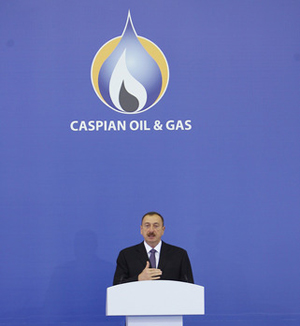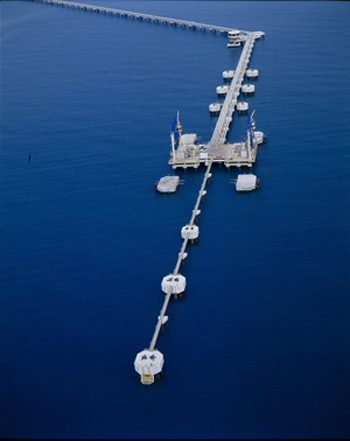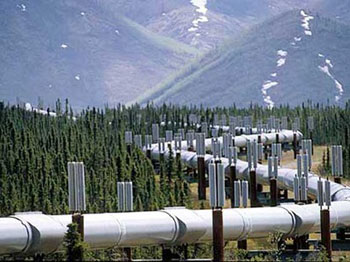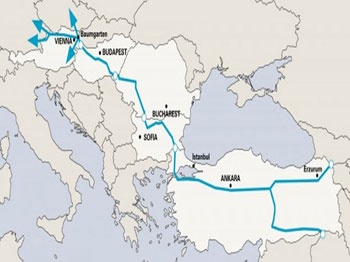Home page
» LAST 10 YEARS
» Strategy of transportation of energy resources
Strategy of transportation of energy resources The first oil transportation routes In the mid-90s of last century Azerbaijan had just one route to transport its oil - the Northern route. Azerbaijani oil was transported mainly via the Baku-Novorossiysk oil pipeline on the Black Sea port of Novorossiysk with 1330 km length. Bilateral agreement to transport oil with this pipeline was signed in Moscow on February 18, 1996. The parties agreed on legal and technical issues transportation of Azerbaijani oil via Russia by this contract. In accordance with the original terms of the contract since October 25, 1997 transportation of Azerbaijani oil to the world market through the northern pipeline began. At the same time, Azerbaijan had conducted a policy serving national interest to get availability of alternative oil transportation routes. In spite of all the political risks on March 8, 1996, the President of Azerbaijan Heydar Aliyev and Georgian President E. Shevardnadze agreed on construction of Baku-Tbilisi-Supsa pipeline. Trilateral contract signed by the Azerbaijan International Operating Company (AIOC), set by the companies participating in Contract of the Century, SOCAR and the Georgian government expected to transport initial Azerbaijani oil extracted from Azeri, Chiragh, Gunashli fields via Baku-Supsa oil pipeline. The first Azeri oil began to be exported via the Baku-Supsa oil pipeline on April 17, 1999. The major advantage of this route is marketing Azerbaijani oil to global markets in purified condition under the brand of Azeri light”. In addition, other advantage of Supsa oil pipeline is to have low-cost transportation of oil compared to Novorossiysk pipeline. Thus, the transportation of one ton of oil via Novorossiysk cost 15,67 USD but 13,14 USD per ton via Supsa. Length of the Baku-Supsa oil pipeline to the west is 837 kilometres, and pipe diameter is 530 mm. The commissioning of the Baku-Supsa pipeline founded the Southern energy corridor, and for the first time in independence history Azerbaijan has an alternative route to transport oil. The Baku-Tbilisi-Ceyhan Main Export Pipeline of global importance  Baku-Tbilisi-Ceyhan main export oil pipeline (BTC) named after Heydar Aliyev, commissioned in 2006, is the most important event based on the national interests of the country, strengthening the independence and for continuation of the oil transportation strategy,. The oil (about 1 million barrels a day) produced under the Contract of the Century, is transported through this pipeline to the world market. The length of BTC pipeline is 1768 km, and its construction finished in 2005. On May 28, 2006, the first oil pumped into the pipeline reached Turkish port of Ceyhan. The official opening ceremony of the pipeline was held at the port of Ceyhan on July 13 of the same year and in Istanbul with the participation of high-level officials from 98 countries. The implementation of the strategic important BTC pipeline Project is the result of complex negotiations, of long-lasting tensions. It is expected to transport 50 million tons of Azerbaijani oil via BTC pipeline. From the date of commissioning of the BTC till May 30, 2012 185,9 million tons of Azerbaijani oil was de
livered to world markets from the port of Ceyhan. BTC oil pipeline is of great importance in terms of energy security for Azerbaijan, Georgia, Turkey and whole region, Europe and in general from economic and political context for the world. As the BTC pipeline is economically feasible some states intend to transport its oil through this pipeline. Thus, Azerbaijan and Kazakhstan signed an agreement on transportation of Kazakh oil via BTC. Diversification in gas transportation: the fundament of southern gas corridor is laid  Azerbaijan bases to policy of having diversified gas transportation routes in addition to the diversification of oil. Following the launching of the Baku-Supsa pipeline the works began to implement project of the South Caucasus Pipeline (Baku-Tbilisi-Erzurum gas pipeline) to transport gas from Azerbaijan to Turkey. Its construction began in 2004 and ended in late 2006. A part of gas produced from Shah Deniz field (Phase-I)of Azerbaijan in the Caspian Sea is transported via pipeline (approximately 7.7 billion cubic meters per year) from Baku to Erzurum in Turkey. This pipeline with length of 970 kilometres, cargo capacity of 30 billion cubic meters a year was constructed in parallel to Baku-Tbilisi-Ceyhan pipeline. In accordance with the agreement signed with Turkey, Turkey has to buy 91,0 billion cubic meters of gas through this pipeline over 15 years. On March 13, 2007, the first Shah Deniz gas was pumped into the pipeline. The South Caucasus oil pipeline opens up opportunities not only for delivery of Azerbaijani gas to markets of Turkey but from there to the European markets. Azerbaijani gas is already transported to Greece from Turkey via the South Caucasus Pipeline. Newly opened Northern route for Azerbaijani gas transportation once was considered as a surprise to many people. Because Azerbaijan self used to purchase a gas from Russia in past, and needs in gas are provided thanks to imports from this country. However, the successful energy strategy of Azerbaijani entirely eliminated the dependence of country on gas imports from this country. In 2007 Azerbaijan had stopped buying gas from Russia and began to provide the demand on account of its internal resources. Very shortly Russia self became one of the countries exporting Azerbaijani gas. The contract for the sale of gas between Azerbaijan and Russia was concluded between Gazprom and SOCAR on October 14, 2009. The contract covers with the possibility of further extension of the period 2010-2015. Basing on that contract Azerbaijan began to transport gas from Azerbaijan to Russia in January 2010. That year 800 million cubic meters of Azerbaijani gas was transported to Russia. Subsequently, the volume of natural gas transportation increased and in 2012 the figure is expected to reach 2 billion. cubic meters. Gazprom plans to increase the volume in 2013 to 3 billion cubic meters. One of the factors showing importance for the region\'s energy strategy is provision needs in gas of a strategic partner of Azerbaijan in the region, Georgia. Presently Azerbaijan transports gas to Georgia via Hajigabul-Gazakh-Gardabani gas pipeline and meets the needs of this country in gas. Hajigabul-Astara-Biland pipeline extending in the direction of Iran is one of 4 routes used in gas transportation. The selection of a route for the transportation of Shah Deniz-II gas  The complicated processes lasted for years around the selection of routes for the transportation of gas to be produced in the II phase of “Shah Deniz field, having large gas stocks, at last are being successfully finished in terms of the national interests of Azerbaijan. The selection of route for the transportation of gas Shah Deniz-II was one of the main priorities of the policies of world’s most powerful states in the South Caucasus region for a long period. Both political and commercial interests played role in this issue. Discussions for a long time held around the Nabucco project supported by the European Union and the United States. The authors of the project saw “Nabucco pipeline as an integral part of the Southern Gas Corridor. Azerbaijan selects the most cost effective option Azerbaijan has demonstrated a position on this project that meets its national interests; President Ilham Aliyev has repeatedly stated that he supports Nabucco Project. On the other hand, Azerbaijan has demonstrated its will to achieve the most favourable conditions of the transportation of its gas resources in world markets, for this end used an offensive strategy. Besides supporting Nabucco project for strengthening its position in negotiations with transit countries and potential buyers carried out the successful diplomacy to open new routes for other transportation. As an offensive strategy the first step was made in 2010, in Bucharest with AGRI (Azerbaijan-Georgia-Romania interconnector) project. The main advantage of this project is small number of transit countries and this Project is considered to be suitable for the Access in the market of European countries. The cost of AGRI, expecting transportation of liquefied natural gas from Azerbaijan through Georgia and Romania is 2-4 billion Euros depending on the volume of gas. The volume of gas to be transferred is planned in stages from 2 billion cubic meters to 8 billion cubic meters. The second major step was a gas agreement between Azerbaijan and Turkey signed in the same year. The agreement also includes the construction of a new pipeline connecting Azerbaijan and Turkey. From one hand steady rise in price of Nabucco pipeline project to be extended from the shores of the Caspian to Austria and on the other hand, delaying of signing of contracts on gas sales and purchase between producers and potential buyers of the gas through “Nabucco and conducting of the successful policy by Azerbaijan for realization of alternative transport routes for delivery of its gas to buyers on most favourable conditions led to reconsideration of this project. Nabucco» consortium has suggested the reduced version of the project in 20110, Nabucco West project. In parallel to it the important step towards the implementation of the agreements initiated in 2010 on construction of a new pipeline between Azerbaijan and Turkey, was made. TANAP pipeline contract  On June 27, 2012, Azerbaijan\'s President Ilham Aliyev and Turkish Prime Minister Recep Tayyip Erdogan signed an agreement on TANAP Trans-Anatolian gas pipeline. Contract aims to transport 16 billion cub.meters of gas produced at II phase of “Shah Deniz field to Turkey. 6 billions of this amount will be used for domestic demand, 10 billion cubic meters of gas will be transported to European markets via Turkey. TANAP Project that established with partnership of State Oil Company of Azerbaijan and Turkish BOTAS and TPAO will be implemented in six years, with an investment of $ 7 billion. The pipe diameter is 56 inches or 1.4 meters. In the future, it is possible to increase the capacity of the pipeline. The project will be implemented in 4 stages. Its first phase will be completed in 2018, and in 2020 the capacity of the pipeline will reach16 billion cubic meters, 23 billion cubic meters in 2023, 31 billion cubic meters in 2026. The gas intended for Europe will be delivered at Turkish-Bulgarian or at Turkish-Greek border. To Turkey with TANAP and from there to Europe with Nabucco West On June 28, 2012, the Shah Deniz” consortium finalised the evaluation phase of potential gas export routes in the direction of South-Eastern and Central European. It was declared that Nabucco West” project was chosen as option of export of natural gas to be produced within Phase 2 of the development of the field to the Central Europe. Thus Azerbaijani gas to be transported to Turkey by TANAP pipeline will be marketed via Nabucco West to Europe. If Nabucco project aimed to purchase of gas at the border but due to unification of “Nabucco West project to TANAP gas will be sold in Europe at a higher price. In addition, the Nabucco West is intended only for the export of Azerbaijani gas. All implemented projects will increase Azerbaijan\'s role in ensuring the energy security of Europe. The strategy of Azerbaijan on transportation of gas is based on a provision of its state and economic interests. This strategy will further strengthen the position of the Azerbaijani state in the region and the world, has created an opportunity to turn it in reliable energy partner for Europe.
|
